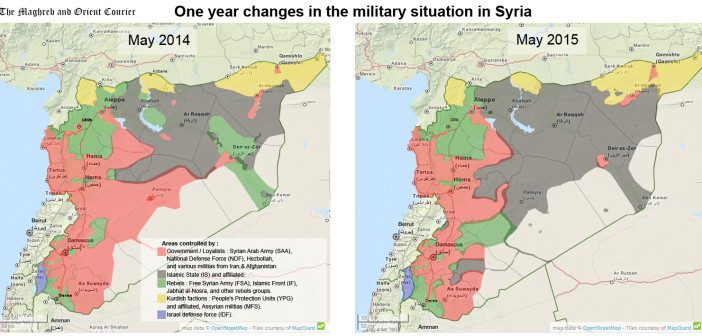Since February 2015, Syria has entered its 4th year of a full, intense and bloody war. One year ago, in May 2014, despite a few setbacks, loyalists (Syrian government) seemed to hold firmly after series of important battles in 2013 reasserting their control over important and strategic areas such as Aleppo or near the Lebanon border. At the same time, rebels suffered both loyalists offensive and a deadly infighting with the Islamic State of Iraq and Sham (ISIS), later renamed Islamic State (IS). In such a complex and dynamic war, one could imagine that the situation was to change, and indeed dramatic events such as the offensives of the Islamic State led to a very different strategic situation one year after.
Click on image to enlarge it
The 2014 Islamic State offensive
In June 2014, the sudden invasion of Iraq by the Islamic State, and the fall of Mossul, led to a quick strengthening of the jihadist group. In the same time, they achieved to conquer the remaining rebels-held areas in Deirez-Zor and Raqqah in Syria. These conquests mostly happened by receiving allegiance of rebels groups, while the others fled to Western Syria or, in some rare cases (such as the Shaytat tribe) tried to resist. During the summer of 2014, the IS turned their attention to some isolated loyalist army bases (Regiment 17, Regiment 121, Tabqah air-base, and Ayn Isa) and stormed them. The result was heavy human losses for the government troops, as well as important stock of weapons an ammunitions seized by the IS.
The IS also increased their presence in the Syrian desert, giving permanent pressure to loyalist-held gas fields as well as to their supply roads (Hama – Aleppo and Homs – Deirez-Zor). As a result, Palmyra was conquerred after 7 days of fighting on May 21, rising high concern in the international community about the fate of the city relics. In addition, they achieved to advance further to the West in rebels-held areas in Suwaydaa, Damascus (South Ghouta and Yarmuk camp) and in the Qalamoun mountains near the Lebanese border.
Resistance of the Kurds and intervention of the International coalition
In the North, in September 2014, the IS launched a wide-scale campaign in order to conquer the Kobane canton which was ruled by a Kurdish PKK affiliated militia, the People’s Protection Units (YPG). The sudden attack advanced very quickly to the streets of Kobane city where a 4-months heroic resistance from the YPG stopped the jihadists. The battle could have lasted for a long time, but the US-led international coalition started to bomb IS targets in Kobane, giving an important strategic support to the embattled defenders. After months of street fighting, the YPG which received help from some Free Syrian Army (FSA) and Iraqi Peshmerga units, succeeded in breaking the Kobane siege in January 2015, and started a Reconquista war which is still continuing in May 2015.
Further in the East, in the al-Jazeera canton which is the most important Kurdish-held territory in Syria, the IS advance reached the Iraqi border post of Yarubiyah, threatening a major supply road for YPG. In December 2014, the Peshmergas in Iraq launched an offensive vs the IS to recapture Yazidis-inhabited areas in Mount Sinjar. At the same time, YPG attacked the IS positions on the other side of the border and liberated several areas. A few weeks later, the YPG captured cities of Tal-Hamis and Tal-Brak. On the Western side of al-Jazeera canton and of Hasakah city, the IS conquered the south bank of Khabur river, capturing hundreds of Syriac and Assyrian civilians, and reached the gates of Tal-Tamer, biggest Christian town in the area. However, by the end of April 2015, the YPG, helped by Syriac militias (MFS) and some Arab (Sanadid tribe), launched a powerful counter-offensive West of Tal-Tamer and in Khabur valley and advanced quickly, cutting Hasakah-Aleppo road, and aiming toward Mount Abdel-Aziz where IS logistic bases are located.
Rebels strengthening in the North and the South
The non-IS rebels are composed of various alliances. The Free Syrian Army (moderate, FSA) lost some ground in the north after some infighting with Jabhat al-Nusra (jihadist al-Qaeda affiliated) led the former to take control of a large territory in the Idlib governorate. However, they are the strongest faction in South Syria near the Jordanian border (Daraa, Quneitrah, south Rif Dimashq). The Islamic Front (Islamists, IF) is based in all rebel-held areas, but has its strongests positions in Aleppo, Idlib and Damascus. Jabhat al-Nusra is mainly active in Aleppo, Idlib, Latakia and Qalamoun.
The rebels advanced regularly in the South, taking over important areas and cities such as Sheik Miskin, Quneitrah, and Bosra, and tried to advance further north toward South of Damascus. Good supply line with Jordanian border, good command and coordination, and foreign funding and logistical help can explain rebel successes in this area.
In the North, in December 2014, the rebels managed to capture remaining loyalist bases of WadiDeif and Hamidiyah, seizing important amounts of weapons and ammunitions. In March 2015, a new coalition called “Army of Conquest” managed to seize the provincial capital, Idlib and to capture Jisr ash-Shughur one month later, endangering remaining loyalist-held cities in the Idlib Governorate.
Loyalists at best maintain stalemate
The loyalists indeed experienced a difficult year and mostly managed to defend positionsat best, or retake some lost areas, paying heavy price in casualties and lost materials. They lost and recaptured Kessab in Latakia, gained and lost some villages in north Aleppo in a desperate attempt to reach a besieged chiite enclave, recaptured a part of lost territory in south Rif Dimashq and Quneitrah, lost and retook Shaer gas field, and most recently lost Palmyra. In Damascus itself, the loyalists did not succeed in further reducing the rebel pockets in East of South Ghoutah or in Jobar. However, some important Hezbollah involvement allowed the Syrian Arab Army (SAA) to make substantial gains in the Qalamoun mountains in May 2015, and in Deirez-Zor, they managed to resist to several attacks from the IS, still maintaining half of the city under government control.
In summary, the last year since May 2014 has seen a strong development of the Islamic State at the expense of the rebels (mainly by allegiance) and of the loyalists (by conquering). They were however unsuccessful in further advancing in the north where the Kurdish YPG managed to stop them with the help of the International coalition air-strikes. Although subject to sporadic infighting, rebel factions managed to gain territory in the South (Daraa) and in the north (mostly Idlib) and strengthened their positions in Aleppo. The loyalists experienced important defeats and had heavy casualties in losing some besieged army bases. Meanwhile, except along the Lebanese border where they get strong Hezbollah involvement, they mostly defended territory against rebels and IS attacks, and did not succeed in advancing in Damascus and Aleppo.





5 Comments
Great maps!
However, I think you downplay in the text the crucial role of Jabaht Al Nusrah (= Al Qaeda; we all need to emphasize this affiliation) as leader, vanguard and catalyst of rebel successes. In many succesful fronts, the rebels could be aptly described as “JaN & allies”.
I agree although in the North they are only one component of the “Jayh al-fatah” (Army of conquest) with Islamic Front affiliates and some FSA affiliates. Also in numbers they are far less than IF
Pingback: Syria: Situation in Palmyra | al Watan
Pingback: Agathocle de Syracuse | Syria – One year changes in the military situation (May 2015) (Maghreb and Orient Courier)
Pingback: Le Phénix kurde